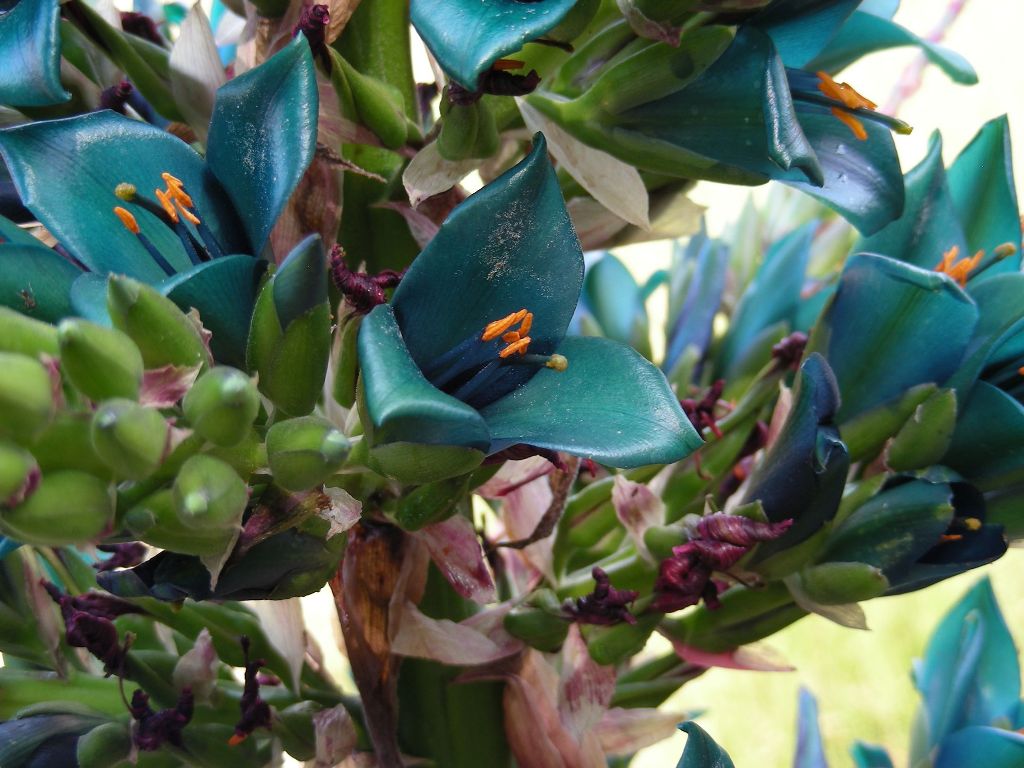
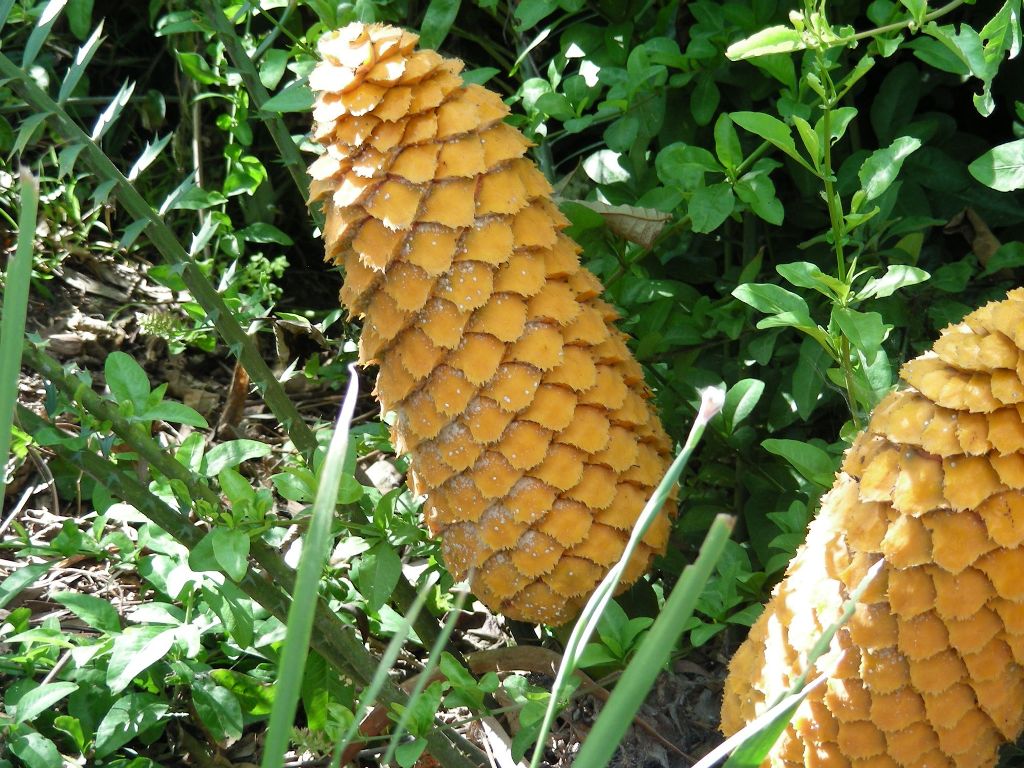
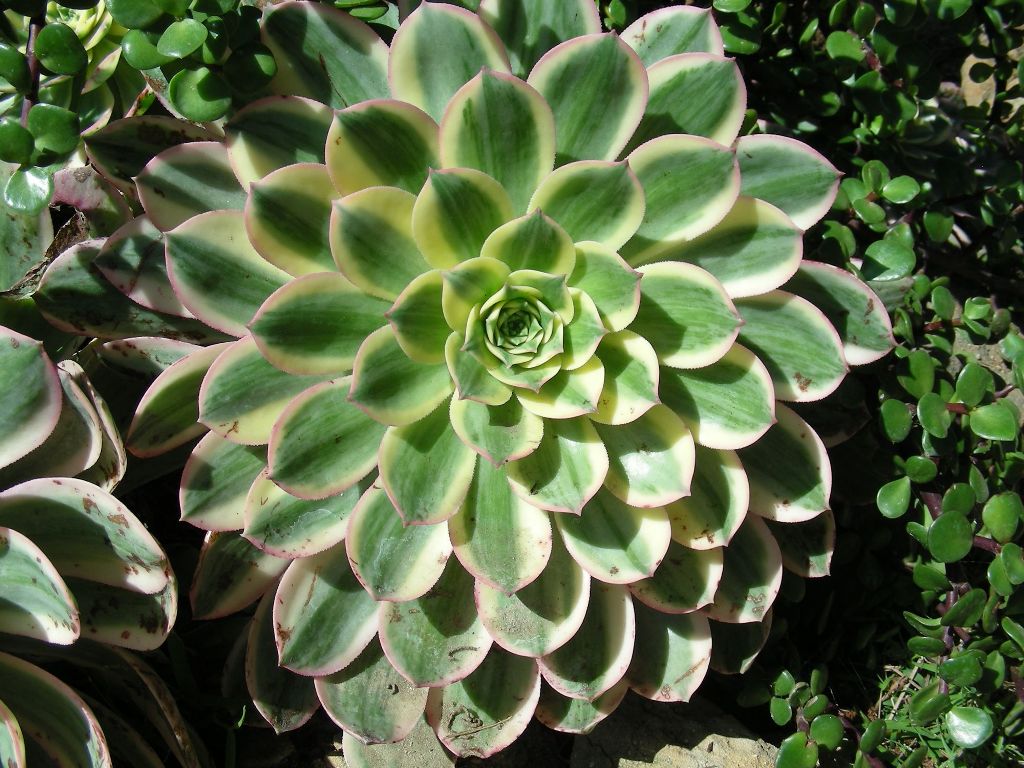
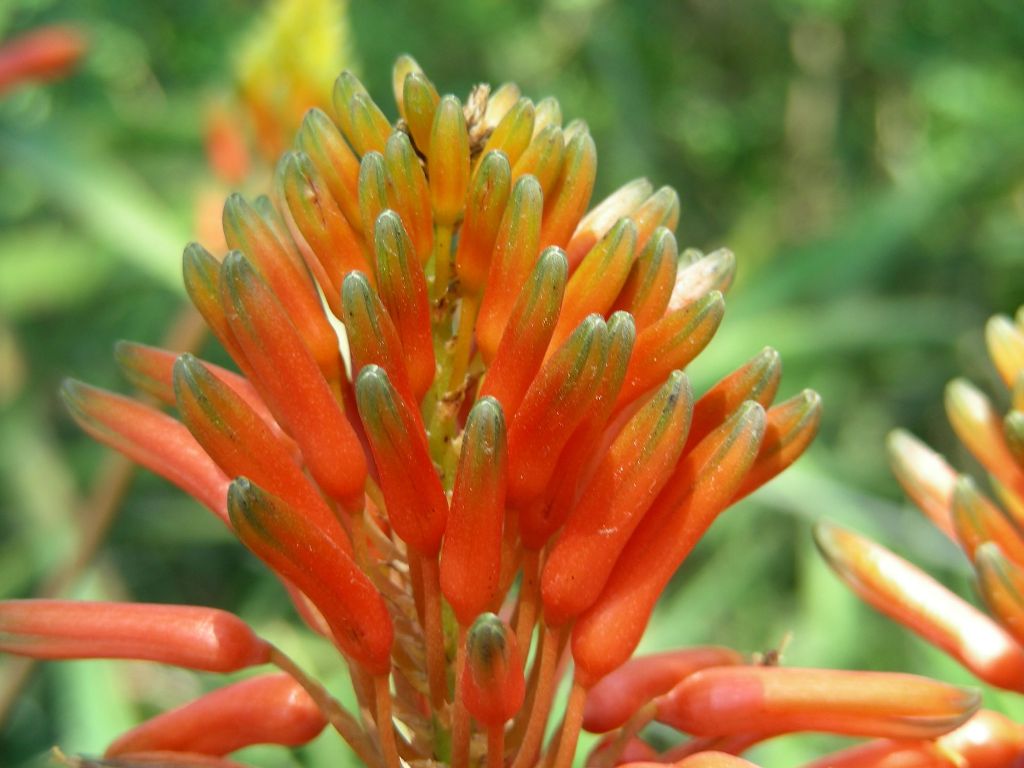
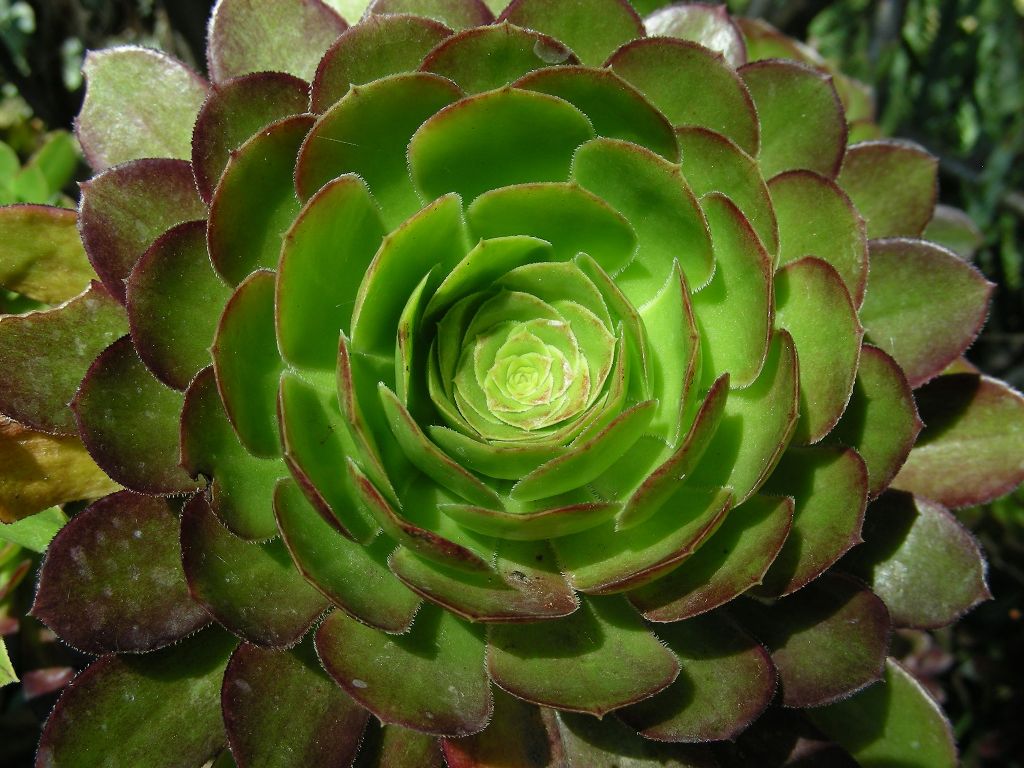
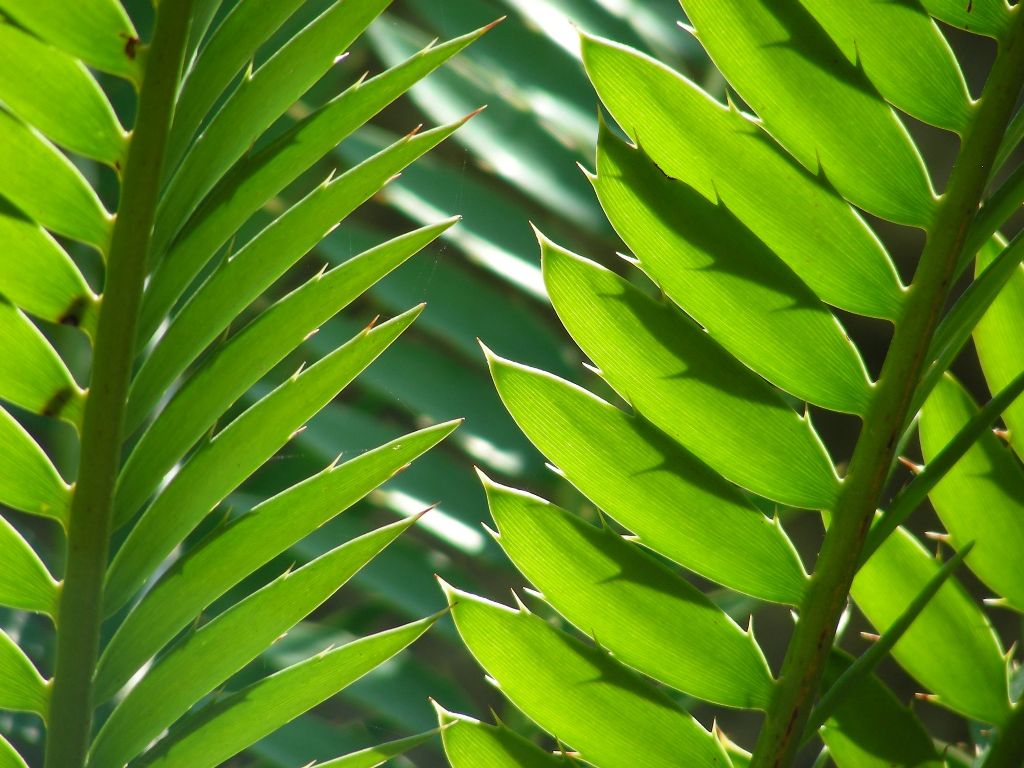
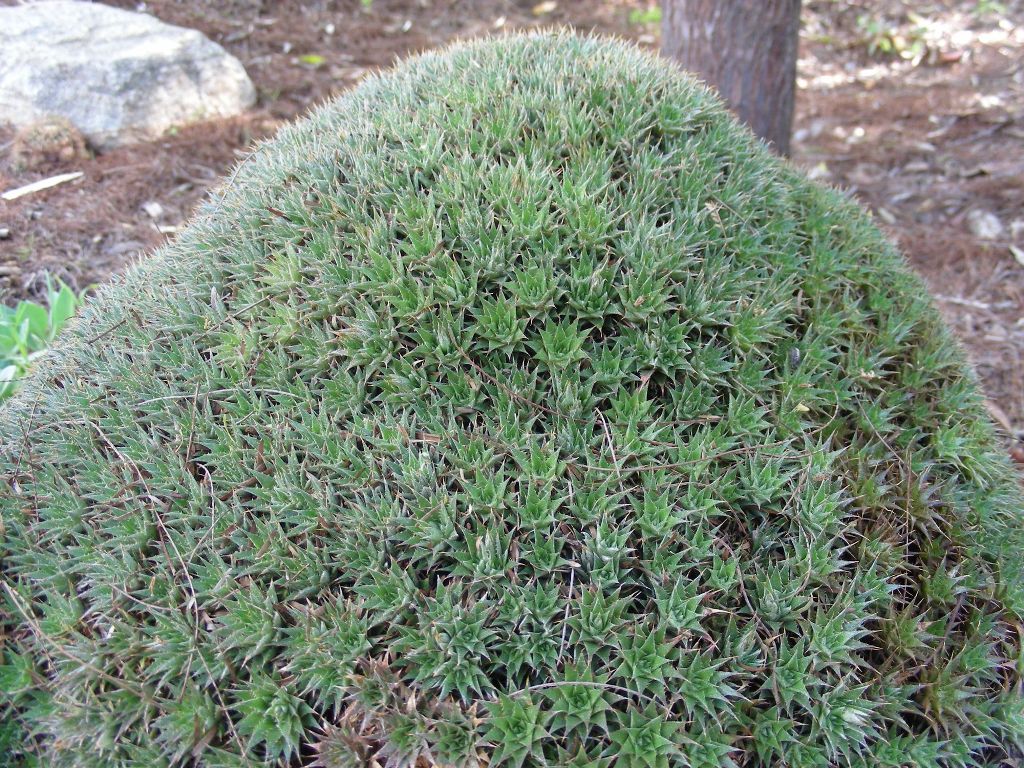
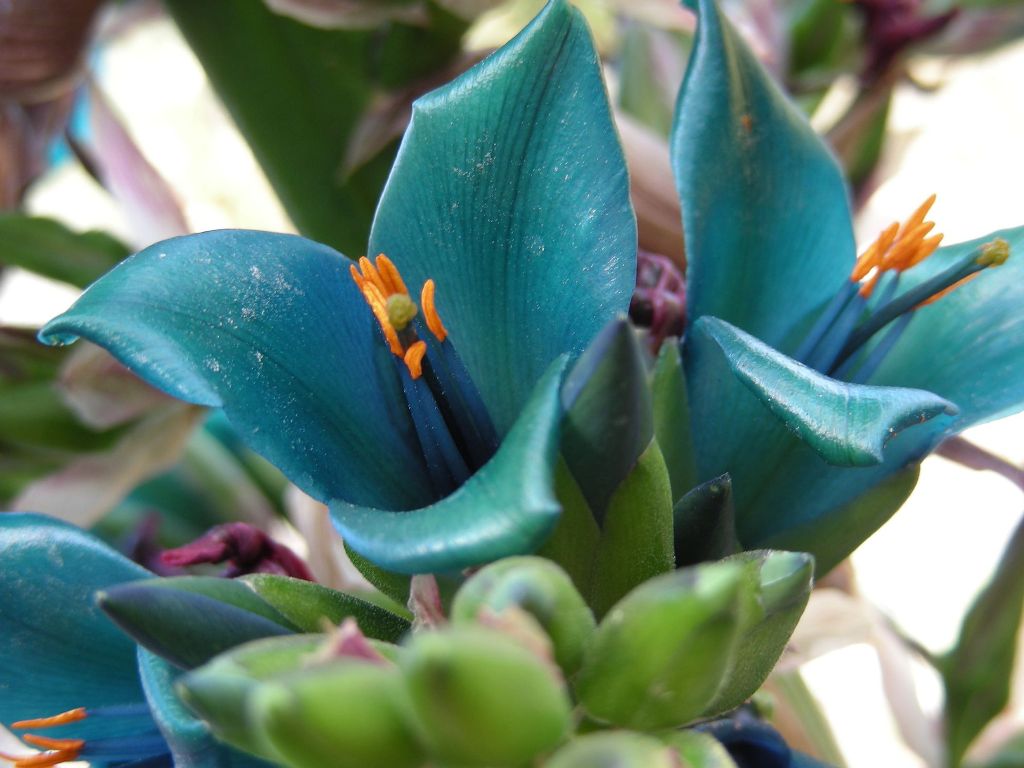

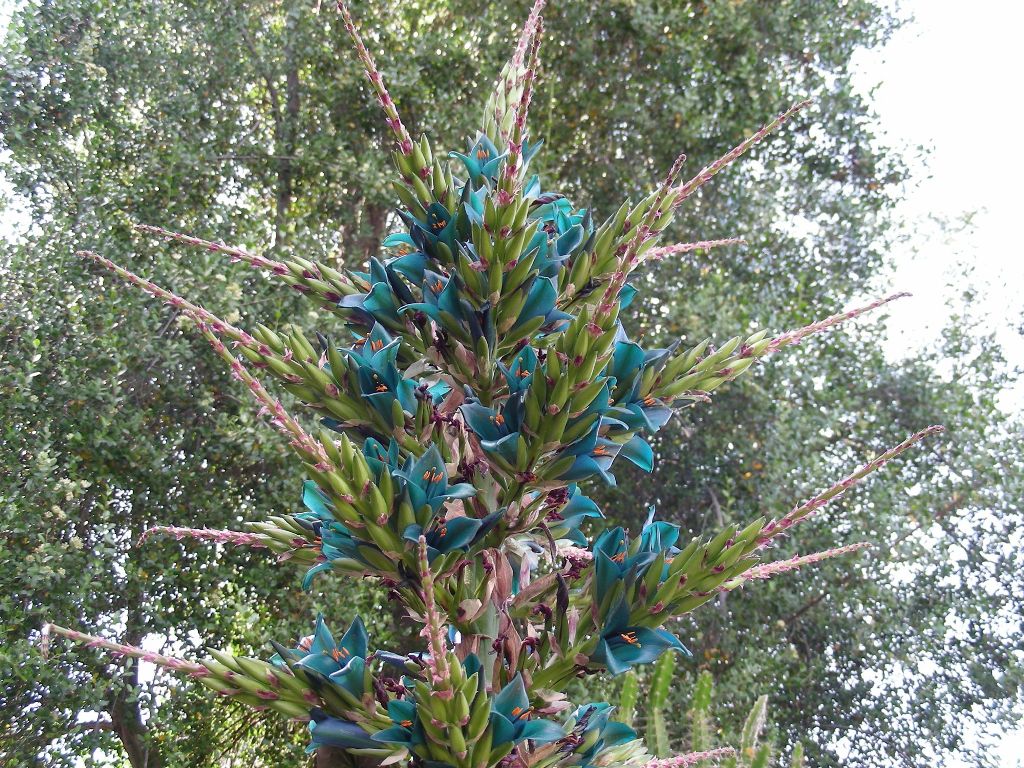
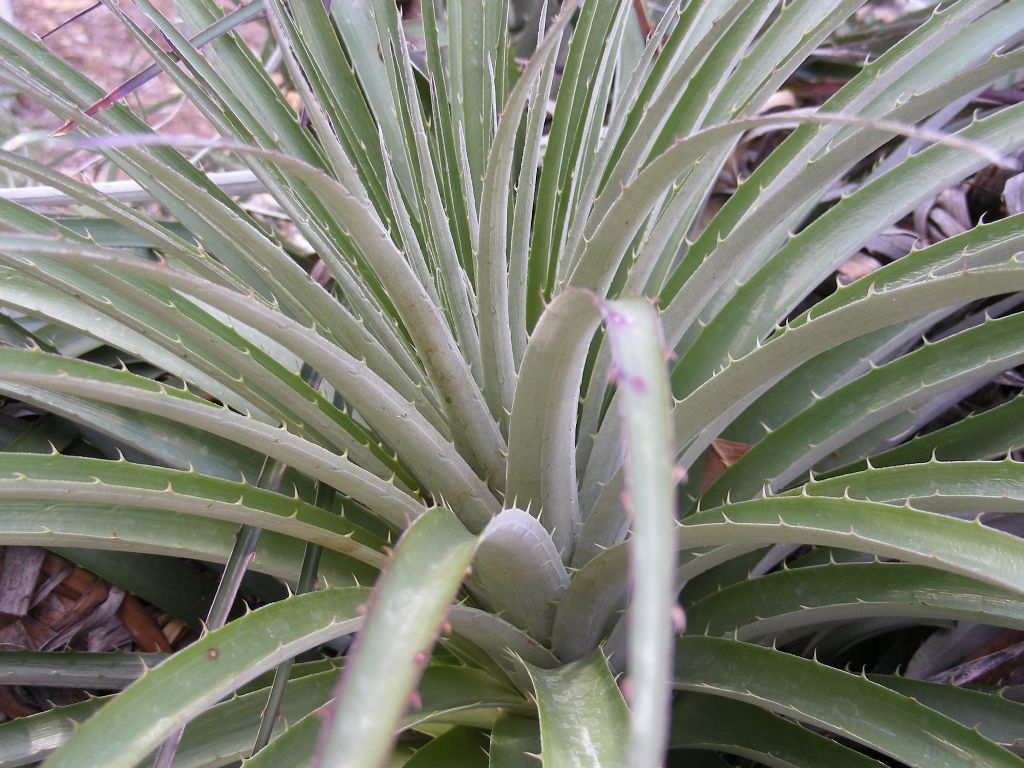
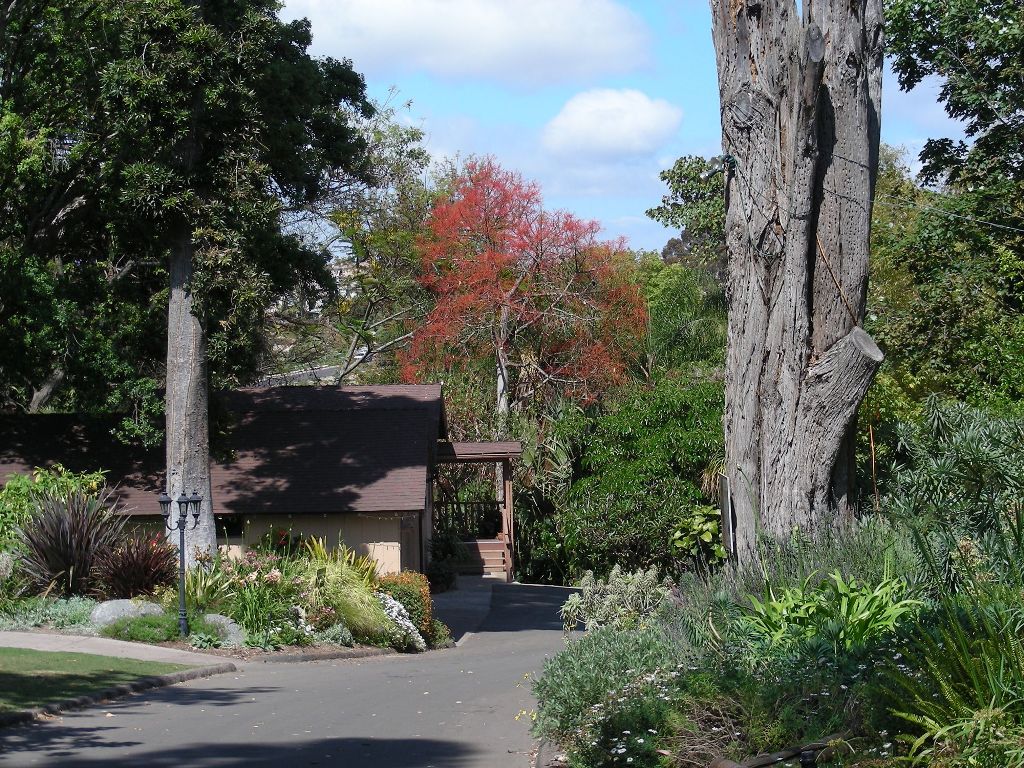

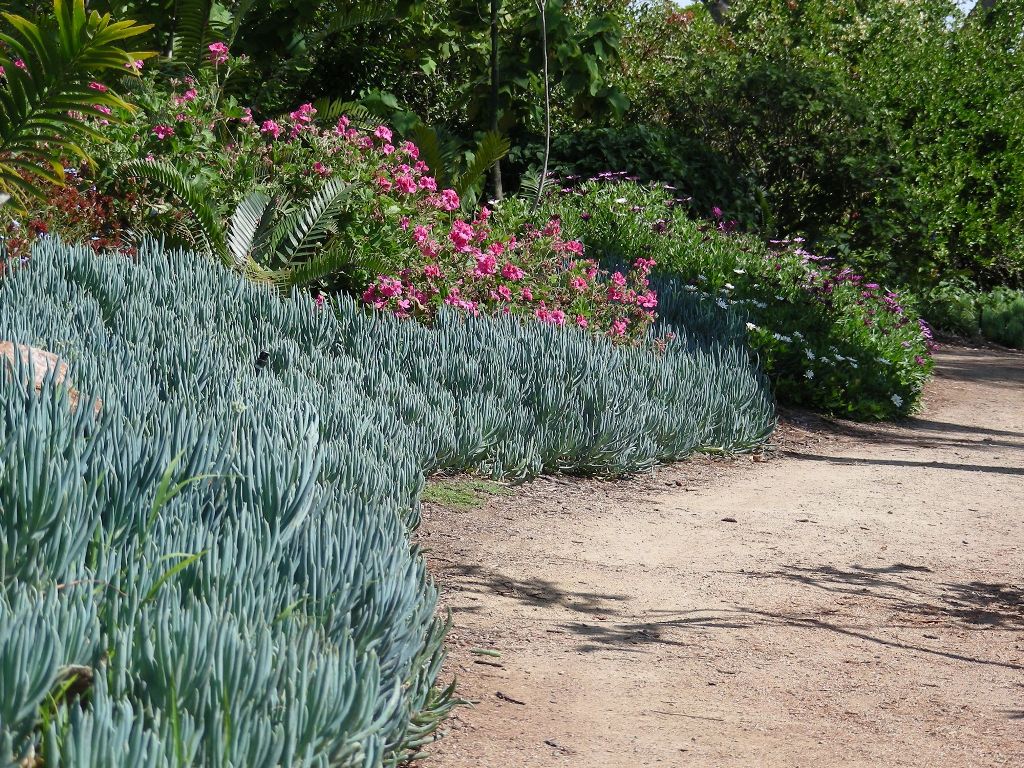
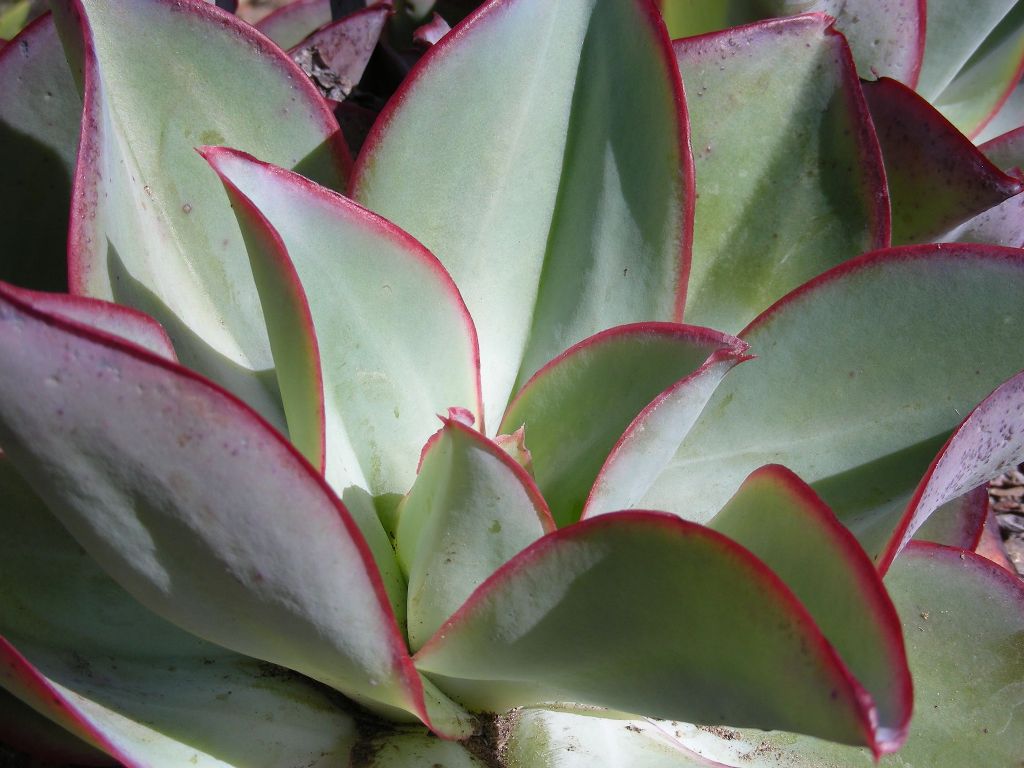

















Standing in front of the spiky stalk of Puya alpestris, I understood why someone had named it “Sapphire Tower.” I take that back; I’m not sure sapphire is exactly accurate. Randy Baldwin, general manager at San Marcos Growers (my favorite wholesale nursery) describes it at their website:
Turquoise blue-green flowers (sometimes called metallic or “unearthly”) bloom on terminal branching 4-5 foot tall stalks in the spring. Equally exquisite as the petals are the bright orange anthers contrasting the teal blue.
| |
 |
| |
|
 |
|
I half expected laser beams to start shooting out of the ends of the buds.
But who wants to call a plant Turquoise Blue-Green Metallic Unearthly Tower? They don’t make plant tags that big.
I remember the first time I saw a puya in bloom. I had been alerted by a flurry of e-mails that something tantamount to discovering the burrow of the Easter Bunny had occurred. “OMG! You’ve GOT to see the puya at Orpet Park! It’s FLOWERING!!!” (I know, way too many exclamation marks, but that’s how excited my horti-buddies were.)
Arriving at the park, I understood the fervor. I was at a loss for words to describe the color of the bloom. Not unlike Randy’s description, my thoughts went to a sci-fi B-movie (make that D-movie). Otherworldly, indeed, if you call “teal” otherworldly.
I beheld the plant in its full splendor again a few weekends ago while visiting San Diego with my wife, Lin. That was the same trip when I finally met my Flickr buddy, Roberta Correia, the subject of my last blog post.
Before I left Roberta’s house, I mentioned that Lin and I might be going to Quail Botanical Garden. Her eyes glazed over, a trance-like state taking control of her faculties. “You HAVE to visit the puya! I was just there last week and it’s in full bloom,” she demanded. “It’s hard to find, but it’s worth it.”
Such enthusiasm. Maybe puya exudes some sort of nirvanic pheromone. This could be fun. So that same afternoon, we drove thirty minutes north of San Diego and were greeted by late afternoon sunlight, the kind that adds a gentle, warming glow to a garden.
| |
 |
| Quail Botanical Gardens has changed its name to the San Diego Botanic Garden. |
Quail was once the 30-acre private estate of Charles and Ruth Laribee, avid plant collectors who left the property to the County of San Diego in 1957. In 1993, a non-profit was formed. Their mission is to actively participate in the conservation of rare, threatened and endangered plant species. No doubt about it; the puya is right at home here.
Puya is a form of bromeliad (like a pineapple) native to the dry slopes of the Chilean Andes. It grows in full sun, is succulent—so it doesn’t require much water—and enlivens the garden year-round with its viciously serrated silvery leaves. It can stand low temperatures between 15 and 20 deg. F. I’ve seen them as large at four feet high and equally wide, so if you plant one, leave adequate space.
|
|
 |
| Imagine weeding under these bad boys. Imagine the copay at the emergency ward. | |
I’ve never used Puya alpestris in a design project, for two reasons. First, I would hate to have my client or their gardener weed around the plant. I’m not kidding about the sharp teeth along the edge of the leaves. Short of wearing a pair of those elbow-length heavy leather rose pruning gloves, I don’t want to subject anyone to multiple stitches when they garden.
Secondly, and closer to home for this designer, what on earth could you plant that would blend with or compliment the color of these strange flowers? I’ve been through a huge box of crayons, and frankly, I’m stumped.
So I turn to you, my broad base of new-found readers. Have you grown puya? If so, what have you paired it with? I know there are some brilliant colorists among you who can set me straight. I’d love to use the plant, but other than tossing it in as a stranger-than-fiction oddity, my artistic mind is a blank.
If you have any creative ideas, leave a comment.
Now enjoy a tour of a few other Quail Botanical Garden lovelies.
 |
| Quail Botanical Garden has an extensive collection of succulents, including this sumptuous Aeonium. |
 |
| Aeonium ‘Sunburst’ can brighten up any bed with its intense variegation and splashy face. |
 |
| There were too many aloes to count. I was attracted by how this one glowed in the high shade of a native coast live oak tree. |
 |
| Found in fossil records from the Cenozoic era, cycads are a stunning foliage addition at Quail. |
 |
| Though some cycads are frequently labeled as palms, they are gymnosperms (“naked seed”) and more closely related to pines and other conifers. |
 |
| This bizarre mound is Deuterocohnia brevifolia. From a single 1-1/2″ succulent rosette, a virtual anthill of foliage grows, wrapping around rocks and trees. Oh yes, it’s another bromeliad, like its cousin, puya. |
 |
| One of my go-to ground covers is blue chalk fingers (Senecio mandraliscae). The vertical form and ice cool leaves make a great foil for any other color. |
 |
| I missed the plant identification label on this one, but succulent expert and garden writer Debra Lee Baldwin helped me out. This lusciously colored specimen is Echeveria subrigida. |
 |
| I have a bone to pick – artificial turf. Yes, it’s hard to grow real turf in high traffic low sunlight spaces. Then how about paving? Artificial turf is an environmental nightmare. I’ll blog about it soon enough. |
 |
| Let’s end on a happy note. A visit to Quail Botanical Garden is a lot less expensive than a ticket to Hawaii. Here palms, cycads and water lilies create a great escape. |


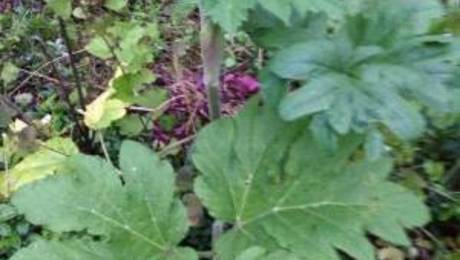














Comments
That puya flower really is strange, esp the colour. You can see why people are going ga-ga over it. So weird to see that teal in a flower. Colours that would work with it are the ones that are already in the flower: a persimmon-like orange, a deep blue, a slightly paler, yellower orange, and a pale orange pink (sort of peach). You could also get away with a hot red, as long as it was softened with a softer peachy pink nearby. Rust colour would be good too. Any combination of greens, inc. pure green, blue greens, (esp soft ones), and an acidy yellow green.
Great collection of pics. Succulents are so varied and beautiful.
Is that artificial turf like the stuff they have in baseball stadiums? What is it anyway, sort of carpet? How do they attach it to the ground? Why on earth would they use it in a botanical garden. Rather shocking. Coming across it here must be like hearing the needle being suddenly dragged across the vinyl.
Puya alpestris? Definitely photo-shopped! That can't be real - the 1970's Turquoisey Teal Blue-Green Metallic colour just doesn't seem natural. If it were real though, and I was going to use it, I wouldn't try to be gentle, I would do something over the top, and bring in other bold colours - reds, yellow, oranges and blues (and maybe throw in some artificial grass too).
Fantastic article and great photos! I, too, remember my first puya sighting. It was at the Korbel Winery Gardens in Sonoma County near the Russian River. The color and texture knocked me back on my heels and I had to have one! I picked up a plant from Annie's Annuals and put it in my cactus garden, where it thrived. I anxiously awaited the first bloom, and was surprised and somewhat disappointed when it turned out not to be Puya alpestris, but, rather, Puya mirabilis, which is white-flowered and generally daintier. I have yet to acquire an alpestris, but I will!
FYI, the Puya mirabilis is easy to garden around; the spikes are not particularly vicious. Also, although it suffers frost damage every year over the winter in my Sunset Zone 14/15 garden, it always bounces right back, and has gotten bigger every year. It might present a good solution for providing your clients with the thrill of a puya without the difficulty of getting that color to work in a larger plan.
Hi Billy. Yes I have used this Puya in a couple of designs. The most successful was used in what I would call a contemporary Western design in which clumps of plants were spaced randomly. It was complemented by puddles of Oenothera that bloomed at a different time and some small Dyckia 'Cactus Ranch Red' plants to echo the Puya growth habit but add color contrast. And, no, it is not a friendly area to weed! But it does look great and attracts plenty of attention.
Whoa, Nellie...we can't grow that in Jersey! No wonder Invasion of the Body Snatchers takes place in California. They're coming, they're coming...
Visiting Wave Hill in the Bronx several years ago, a gardener in the parking lot just about tackled me and made me swear to go find the Puya in bloom. Had never heard of it, but judging from his excitement level, the Puya was worth searching out. So I go trekking through the garden, past the visitor center, across the lawn, through the house and cafe, and onto the patio, & there it was! Metallic teal, indeed! Took tons of photos. Such a great plant.
We have a lot of Puya planted in Vegas, but I have never seen it bloom! Does it take a few years to bloom? We also have a plethora of artificial "grass" around here too. It is interesting to see them vacuum/brush it around the casino's.
Or the tourists on th eground touching it to see if it is real. LOL.
As Alex would say, "holy moley ratit-rolley." And that color is natural?! That is the craziest thing ever.
Colors to go with... picking up the orange of the stamins or the pinky color of the buds? Or maybe due to pruning hazzard and odity factor it is a statement of itself in the garden?
How often does it bloom?
I've been a supporter of Quail Gardens for a long time, and I feel I must come to their defense for using artificial turf in this one VERY small section of the garden. The turf is installed in the Walled Garden, a secluded and pretty spot that is extremely popular for weddings - a crucial source of income for Quail. This little garden hosts as many as five or six weddings per week, year-round, so it has to look good all the time. Putting in the turf was a purely business decision, made reluctantly, as an alternative to the expense and high maintenance of re-seeding or re-sodding the area four or five times a year. Paving the area really isn't an option, as that would make it far less attractive to wedding parties.
It's not an ideal solution, and of course there are environmental issues with the manufacture of artificial turf; but the decision was not made lightly, and the alternative was not very "green" either. I'm sure many other public gardens have had to make similar compromises for economic reasons.
Aloeman: I'm sure there was a lot of debate and hand-wringing, but I'm still not thrilled with giving artificial turf any support. There are many elegant and rich hardscape solutions that would still make for a lovely wedding venue. We can agree to disagree.
Of course! Respectful disagreement is a healthy thing. And I hope I didn't give the impression that I'm any kind of fan of fake turf - I'm certainly not!
Your pictures are gorgeous. That puya is a favorite of mine as well; I don't have it in the garden yet, but maybe someday!
Great ideas and your knowledge is very creative. You have good defined the Artificial Grass, it has more benefit than natural grass. It is a viable and cost-effective alternative to managing a traditional lawn. I have been following your blog for a long time and I find many useful info for my web. Pls take a look at my web and let me know if we can help each other.
Artificial Turf Costs
Log in or create an account to post a comment.
Sign up Log in